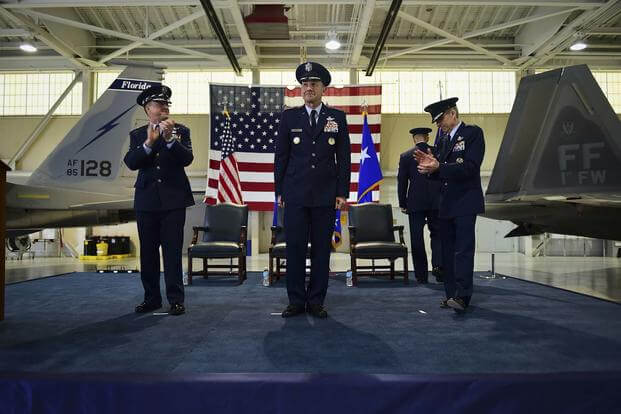Gen. James "Mike" Holmes took over as head of Air Combat Command from Gen. Herbert "Hawk" Carlisle during a change of command ceremony Friday at Langley Air Force Base in Virginia.
Then-President Barack Obama in September nominated then-Lt. Gen. Holmes, deputy chief of staff for strategic plans and requirements at the Pentagon, to pin on his fourth star and lead ACC. He was confirmed by the Senate for the role in December.
Holmes, who joined the service in 1981, is command pilot with more than 4,000 flight hours, including 500 combat hours in the F-15, according to the Air Force. He commanded air combat wings such as the 455th Air Expeditionary Wing, Bagram Air Base, Afghanistan, and the 4th Fighter Wing, Seymour Johnson AFB, N.C., prior to his role at the Pentagon.
Holmes recently said the Air Force could use a "light attack" aircraft -- an idea leadership is currently mulling over, with an experimental flight scheduled this summer -- to help dilute the fighter pilot shortage and gradually increase readiness.
"We don't think it would cost a lot of money, and it's designed just to help us get our arms around [questions like], 'What can you actually do? Does it actually contribute? Can it survive in different threat environments?' " Holmes told Defense News in September.
Carlisle, a 1978 graduate of the Air Force Academy who served four decades in the Air Force, planned to participate in a retirement ceremony Friday night, though his official retirement is set for May 1, Maj. AJ Schrag, spokesman for the command, told Military.com.
He assumed the role as ACC chief in October 2014. In his role, the general saw the Air Force declare the F-35 Joint Strike Fighter "combat ready" when it reached initial operational capability, or IOC, in August 2016.
One month later, the service unexpectedly ordered a temporary stand-down of 13 out of 104 F-35s in the fleet, "due to the discovery of peeling and crumbling insulation in avionics cooling lines inside the fuel tanks," it said at the time. Carlisle took aim at the aircraft's critics when he said there are people "who will make comments, but will never actually have to do anything." As far as he was concerned, Carlisle said, "If a [combatant commander] called me up and said, 'I need these attributes' and the F-35 fits, I would send it tomorrow. No doubt in my mind."
Carlisle also hinted at the prospect of delaying the retirement of A-10 Thunderbolt II -- a move that could have shelved some Warthog units as early as 2018.
"I think we would probably move the retirement slightly to the right," he said in 2015. "I think moving it to the right and starting it a bit later and keeping the airplane a bit longer is something to consider, based on things as they are today and what we see in the future," Air Force Times reported.
The service announced a few months later it would sustain the A-10 "indefinitely" -- or at least into the foreseeable future.
Carlisle told reporters last month that once he retires, he will move to Washington, D.C. Carlisle has not publicly disclosed prospective job offers.
-- Oriana Pawlyk can be reached at oriana.pawlyk@military.com. Follow her on Twitter at @Oriana0214.




























